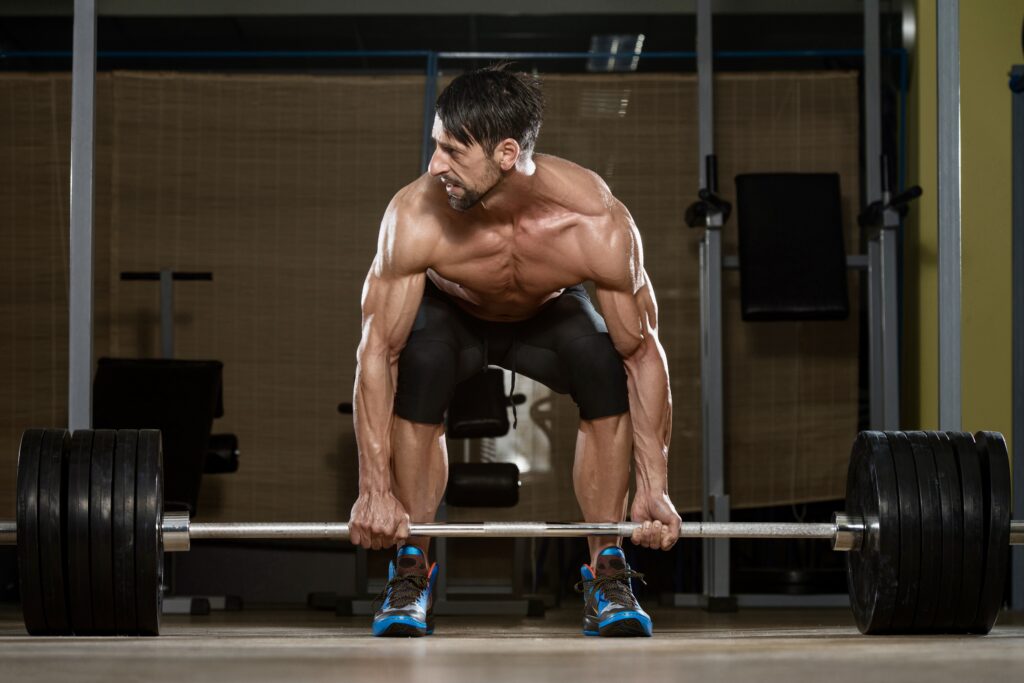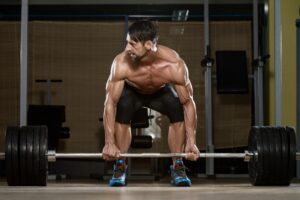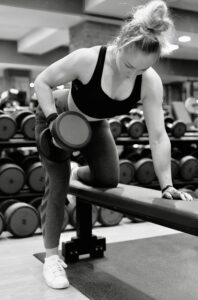
Male Fitness Athlete Lifting Deadlift In The Gym
How Does Weight Lifting Impact The Lumbar Spine And Lower Back?
If you’re someone who enjoys hitting the gym or is interested in weightlifting, chances are you’ve wondered about its impact on your lumbar spine and lower back. After all, with all the heavy lifting involved, it’s natural to have concerns about the potential strain and injuries that can occur in this area. In this article, we will explore the effects of weightlifting on the lumbar spine and lower back, helping you understand the risks and benefits associated with this popular form of exercise. From improved muscle strength to potential spinal stress, we’ll provide you with valuable insights to make informed decisions about your fitness routine.
Effects of Weight Lifting on the Lumbar Spine and Lower Back
Weight lifting is a popular form of exercise that offers numerous benefits for overall strength, muscle development, and body composition. However, it’s important to be aware of the potential impact that weight lifting can have on the lumbar spine and lower back. The lumbar spine, which consists of the five vertebrae in the lower back, plays a vital role in providing stability and support for the upper body. Engaging in weight lifting exercises can increase the load on the lumbar spine, potentially leading to various effects and complications. In this article, we will explore the different ways in which weight lifting can impact the lumbar spine and lower back, as well as discuss prevention and management techniques.

Increased Load on the Lumbar Spine
Weight lifting exercises involve lifting heavy loads, which directly increase the load on the lumbar spine. The biomechanics of weight lifting play a significant role in this increased load. When performing exercises such as deadlifts, squats, or overhead presses, the force exerted on the lumbar spine is magnified due to the leverage and positional demands of the movements. This increased load can place excessive strain on the structures of the lower back and potentially lead to various issues.
Furthermore, heavy loads can directly impact the lumbar spine by compressing and pushing down on the vertebrae. This compression can result in a reduction of space between the vertebrae, putting pressure on the intervertebral discs and other spinal structures. Over time, this can contribute to the development of degenerative changes and even increase the risk of disc herniation.
To mitigate the increased load on the lumbar spine, it is essential to prioritize proper form and technique while lifting weights. Engaging the core muscles effectively and maintaining a neutral spine position can aid in distributing the load more evenly throughout the body, reducing the strain on the lower back. Additionally, gradually progressing the weight and incorporating appropriate training volume can help avoid excessive loading on the spine, allowing for a safer and more sustainable approach to weight lifting.
Muscle Imbalances and Strains
Engaging in weight lifting exercises can also contribute to the development of muscle imbalances and strains in the lower back. These imbalances occur when certain muscles become stronger or tighter compared to their opposing muscles. Weight lifting often emphasizes the use of specific muscle groups, such as the quadriceps, hamstrings, and glutes, while neglecting others, like the deep core muscles and the erector spinae group in the lower back.
Muscle imbalances can lead to poor movement patterns and instability in the lumbar spine, potentially resulting in strains or sprains. When the muscles responsible for stabilizing and supporting the lower back are weak or underdeveloped, other muscles may compensate for their lack of strength, causing additional stress on the lower back.
To prevent muscle imbalances and strains, proper lifting technique and exercise selection are crucial. Focusing on compound exercises that incorporate multiple muscle groups and movement patterns can help achieve more balanced strength development. Additionally, incorporating exercises specifically targeting the deep core muscles and the muscles of the lower back can improve stability and support in the lumbar spine, reducing the risk of strains and imbalances.
Compression of the Intervertebral Discs
The intervertebral discs, located between each vertebra in the spine, serve as shock absorbers and allow for flexibility and movement. Weight lifting exercises that involve heavy loads can exert significant compression forces on these discs, potentially leading to compression-related issues.
The load distribution on the intervertebral discs varies depending on the specific exercise and lifting technique. Exercises that involve heavy axial loading, such as squats and deadlifts, place more pressure on the discs since the force is transmitted vertically through the spine. This compression can compress the discs and cause them to bulge, leading to discomfort and potentially increasing the risk of disc herniation.
To prevent compression of the intervertebral discs, maintaining correct form and technique is essential. This includes maintaining a neutral spine position and avoiding excessive forward or backward bending of the back. Engaging the core muscles effectively can also aid in reducing the load placed on the intervertebral discs. Additionally, allowing sufficient recovery and rest days between weightlifting sessions can help prevent overloading of the discs and allow them to recover from the compression forces.
Risk of Disc Herniation
One of the potential risks associated with weight lifting is the increased likelihood of disc herniation. Disc herniation occurs when the soft inner core of a disc protrudes through the outer fibrous ring, potentially impinging on nearby nerves and causing pain and discomfort. Weight lifting can contribute to the risk of disc herniation through several mechanisms.
The repetitive loading and compression forces experienced during weight lifting can weaken the outer fibers of the intervertebral discs, making them more susceptible to herniation. Additionally, poor lifting technique that places excessive stress on the discs, such as rounding the back during a deadlift or performing exercises with jerky movements, can increase the risk of disc herniation.
To minimize the risk of disc herniation, it is crucial to prioritize proper spinal alignment and posture while weight lifting. Maintaining a neutral spine position, engaging the core muscles, and avoiding excessive forward bending or twisting can help protect the intervertebral discs. Gradual progression in weight and training volume is also important to allow the body to adapt and strengthen the structures that support the spine, reducing the risk of disc herniation.

Spinal Stiffness and Reduced Mobility
Engaging in weight lifting exercises can potentially lead to spinal stiffness and reduced mobility. The repeated loading and compression forces experienced during weight lifting can cause muscle tightness and limited flexibility, particularly in the muscles surrounding the lower back and the spine.
Spinal stiffness can restrict the range of motion in the lumbar spine, making it challenging to perform movements and exercises effectively. Reduced mobility in the lower back can also increase the risk of compensatory movements and poor form, potentially leading to further issues and injuries.
To address spinal stiffness and improve mobility, incorporating dynamic warm-up exercises and stretching routines specifically targeting the muscles of the lower back and the spine can be beneficial. These exercises can help increase blood flow to the area, promote flexibility, and ensure adequate range of motion in the lumbar spine. Additionally, regular mobility exercises and foam rolling can alleviate muscle tightness and enhance overall spinal mobility, allowing for safer and more effective weight lifting.
Development of Postural Abnormalities
Weight lifting exercises can have a significant impact on posture, potentially leading to the development of postural abnormalities. Imbalances in muscle strength and flexibility, as well as poor lifting technique, can contribute to poor posture and postural deviations such as excessive lordosis (swayback) or kyphosis (rounding of the upper back).
When certain muscles are overdeveloped or tight, while others are weak or lengthened, it can cause an imbalance in the forces exerted on the spine, leading to postural abnormalities. Additionally, performing exercises with incorrect form, such as rounded shoulders during a bench press or excessive arching of the lower back during squats, can further contribute to poor posture.
To address postural abnormalities caused by weight lifting, it is essential to incorporate exercises that target postural muscles and promote proper alignment. Strengthening weak muscles and improving flexibility in tight muscles can restore balance and help correct postural deviations. Additionally, focusing on maintaining proper form and technique throughout weight lifting exercises can also aid in improving posture and reducing the risk of postural abnormalities.

This image is property of images.unsplash.com.
Impaired Core Stability
Weight lifting requires a significant amount of core strength and stability to properly execute exercises and protect the spine. However, weight lifting exercises can potentially impair core stability if the core muscles are not adequately trained or if compensation patterns develop.
Weakness in the deep core muscles, such as the transverse abdominis and the multifidus, can compromise core stability and increase the risk of injury in the lumbar spine. Without sufficient core strength, the spine may lack the support it needs during heavy lifts, leading to excessive strain on the lower back.
To improve core stability while weight lifting, it is important to incorporate exercises that target the deep core muscles. Planks, bird dogs, and dead bugs are examples of exercises that can effectively strengthen these muscles. Additionally, engaging the core muscles and maintaining proper form throughout weight lifting exercises can help promote core stability and reduce the risk of lower back injuries.
Development of Degenerative Changes
Engaging in weight lifting exercises, particularly with heavy loads, can potentially contribute to degenerative changes in the lumbar spine over time. The repeated compressive forces and loading experienced during weight lifting can result in wear and tear on the spinal structures, leading to degenerative changes such as osteoarthritis and disc degeneration.
These degenerative changes often manifest as joint stiffness, pain, and a decrease in overall spinal health. Overloading the spine without proper recovery and rest days can exacerbate these degenerative changes and increase the risk of chronic pain and discomfort.
To prevent the development of degenerative changes, it is crucial to prioritize proper lifting technique and form, as well as incorporate gradual progression in weight and training volume. Allowing sufficient recovery time between weight lifting sessions is also essential to give the body time to repair and regenerate the spinal structures. Additionally, maintaining a healthy lifestyle with proper nutrition and hydration can support spinal health and reduce the risk of degenerative changes.

Prevention and Management Techniques
While weight lifting can potentially have negative effects on the lumbar spine and lower back, there are several prevention and management techniques that can help mitigate these risks and ensure a safe and effective weight lifting practice.
First and foremost, prioritizing proper form and lifting technique is crucial. This includes maintaining a neutral spine position, engaging the core muscles effectively, and avoiding excessive forward or backward bending of the back. Proper form not only helps protect the lumbar spine but also allows for optimal muscle engagement and efficient movement.
Gradual progression in weight and training volume is essential to allow the body to adapt and strengthen the structures supporting the lower back. This includes increasing weights and intensity gradually over time, as well as incorporating rest and recovery days to allow the body to repair and regenerate.
Incorporating exercises that target the deep core muscles, as well as other muscle groups surrounding the lower back, can improve stability and support in the lumbar spine. This can help prevent muscle imbalances, strains, and postural abnormalities that may occur as a result of weight lifting.
It is also important to prioritize spinal mobility and flexibility. Incorporating dynamic warm-up exercises and stretching routines targeting the muscles of the lower back and the spine can enhance overall spinal mobility and reduce the risk of stiffness and limited range of motion.
Lastly, maintaining a healthy lifestyle with proper nutrition and hydration supports spinal health. A well-balanced diet rich in nutrients can promote tissue repair and regeneration, while hydration helps maintain the integrity of the intervertebral discs.
Conclusion
Weight lifting can have both positive and negative effects on the lumbar spine and lower back. While it offers numerous benefits for overall strength and muscle development, it is essential to be aware of the potential risks and take necessary precautions to prevent injury and complications.
Increased load on the lumbar spine, muscle imbalances and strains, compression of the intervertebral discs, and the risk of disc herniation are some of the potential effects of weight lifting on the lower back. Additionally, spinal stiffness, postural abnormalities, impaired core stability, and the development of degenerative changes can also occur as a result of weight lifting.
By prioritizing proper form and technique, gradually progressing in weight and training volume, and incorporating exercises targeting the deep core muscles and mobility, weight lifters can reduce the risk of these negative effects and ensure a safe and sustainable weight lifting practice. Maintaining a healthy lifestyle with proper nutrition and hydration further supports spinal health and overall well-being.









